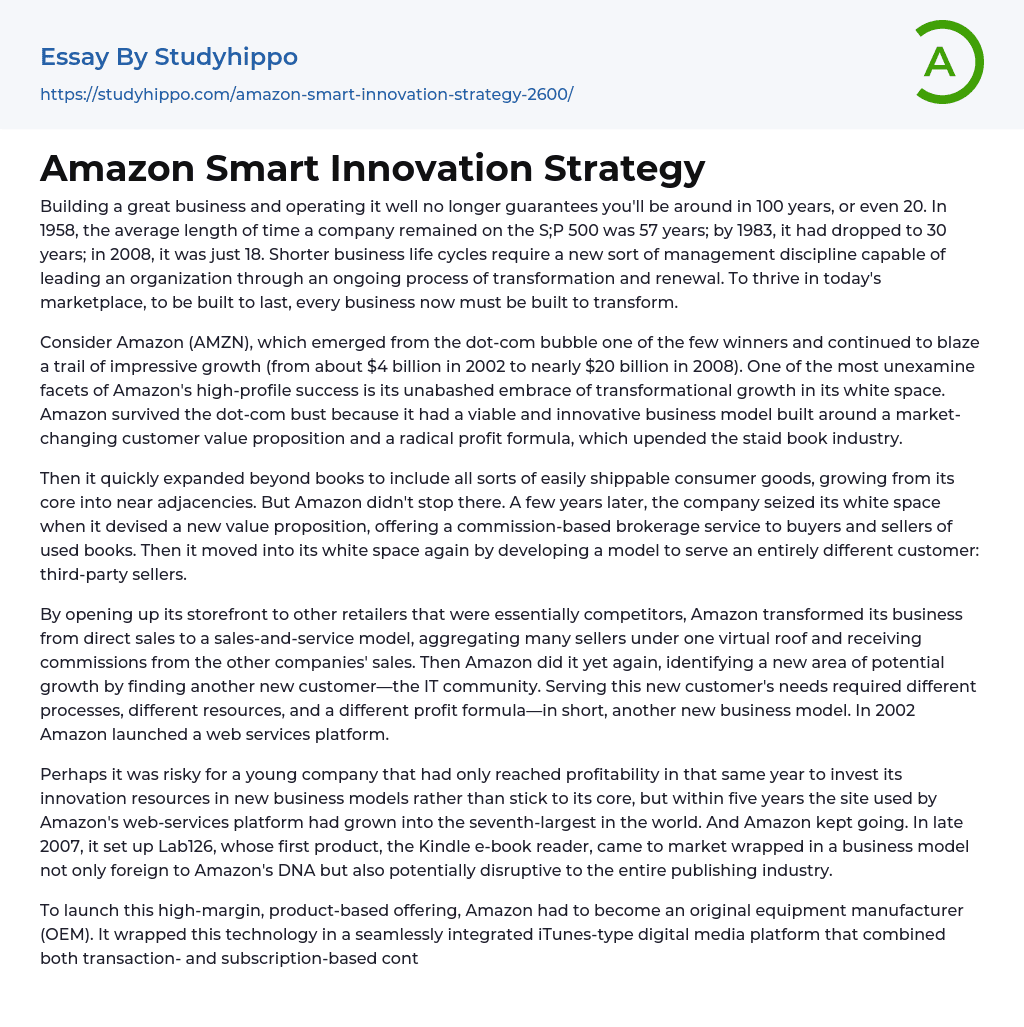Building and operating a successful business is no longer enough due to the decline in business longevity. In 1958, the average tenure on the S&P 500 was 57 years, but it decreased to 30 years by 1983 and further dropped to only 18 years in 2008. These statistics highlight the need for a fresh management approach that can effectively navigate continuous transformation and renewal. To thrive in today's market, every business must prioritize both durability and adaptability.
During the dot-com bubble, Amazon (AMZN) stood out as one of the few successful companies, experiencing impressive growth. From 2002 to 2008, its revenue skyrocketed from around $4 billion to almost $20 billion. One key factor that played a significant role in Amazon's success was its enthusiastic embrace of expansion into untapped markets. Amidst the dot-com crash, Amazon not only survived but flourished by introducing a groundbreaking business model
...that transformed the traditional book industry. This transformation was driven by a focus on customer needs and an innovative approach to generating profits.
Amazon initially concentrated on selling books, but soon diversified its product offerings to include various consumer goods. In addition to this expansion into related areas, the company went even further by launching a commission-based brokerage service for used books, seizing new opportunities. Furthermore, Amazon tapped into another unexplored market by developing a model that caters to third-party sellers.
Amazon transformed its business model by inviting rival retailers to sell their products on its platform, shifting from direct sales to a more comprehensive sales-and-service approach. This move enabled Amazon to consolidate multiple sellers in one virtual space and earn commissions from their sales. Furthermore, Amazon recognized the potential within th
IT community and targeted them as a new customer base, requiring unique processes, resources, and profit strategies. In 2002, Amazon introduced its web services platform to cater specifically to this market.
A young company, despite the potential risks, chose to invest its innovation resources in new business models rather than its core. This decision proved fruitful as within five years, Amazon's web-services platform became the seventh-largest website globally. Expanding further, Amazon established Lab126 in late 2007 and introduced the Kindle e-book reader. Not only did this product have an unfamiliar business model for Amazon but it also had the potential to disrupt the publishing industry.
Amazon became an original equipment manufacturer (OEM) in order to launch this high-margin product-based offering. It integrated this technology into a digital media platform similar to iTunes, which efficiently delivered content through both transactions and subscriptions. Additionally, Amazon collaborated with content producers in unique ways and established an open back-end that enabled independent publishers to produce new content for the Kindle. In the initial year, an estimated 500,000 Kindles were sold by Amazon.
Amazon's expansion into the e-books market has not only positioned the company for success in this industry, but also in distributing newspapers and periodicals. What sets Amazon apart is its innate drive to transform. Whenever it identifies chances to serve new or existing customers in novel ways, it devises and establishes new business models to capitalize on them. Amazon possesses the remarkable capability to simultaneously launch and manage entirely new types of businesses while extracting value from its existing ventures.
- Advertising essays
- Audience Theory essays
- Competitor Analysis essays
- Consumer essays
- Marketing Management essays
- Marketing Mix essays
- Marketing Plan essays
- Marketing Research essays
- Marketing Strategy essays
- Point Of Sale essays
- Price essays
- Procurement essays
- Product essays
- Product Differentiation essays
- Promotion essays
- Promotion And Marketing Communications essays
- Retailing essays
- Trademark essays
- Anheuser-busch essays
- Brands essays
- Detergent essays
- Product Placement essays
- Research Design essays
- New Product Development essays
- Advertisement essays
- Brand essays
- Sales Promotion essays
- Advertising campaign essays
- Consumer behaviour essays
- Offer And Acceptance essays
- Wal-Mart essays
- Discover essays
- Competition essays
- Effective Leadership essays
- Leadership Styles essays
- Public relations essays
- Planning essays
- Mission Statement essays
- Outsourcing essays
- Swot Analysis essays
- Business Analysis essays
- Business Plan essays
- Strategic Management essays
- Strategic Planning essays
- Reasoning essays
- Community Development essays
- Negotiation essays
- Adidas essays
- Amazon essays
- Apple essays




